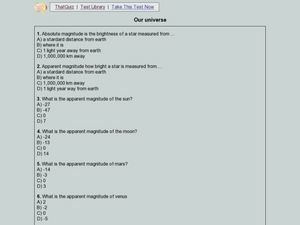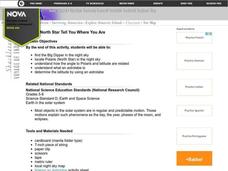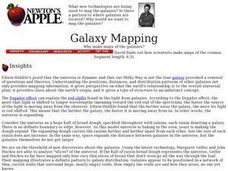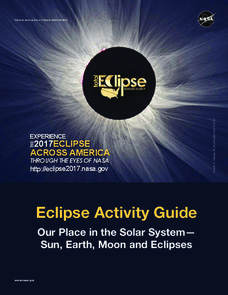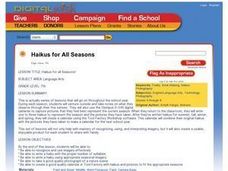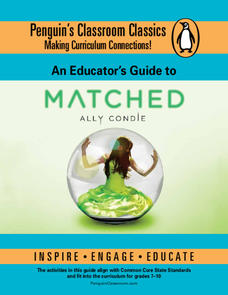Curated OER
Star Cluster Math
In this star cluster math worksheet, students use four different patterns to solve five problems about the fraction of stars classified by their temperature.
Space Awareness
What is a Constellation
Why do some stars in a constellation appear brighter than others? Using a get-up-and-move astronomy activity, scholars explore perspective and the appearance of constellations in the sky while developing an understanding of the...
Curated OER
Let the North Star Tell You Where You Are
Students create an astrolabe and locate the North Star in the night sky. They determine the latitude of the North Star, and calculate an average latitude based on class results.
Curated OER
The Hertzsprung-Russell Diagram
In this astronomy worksheet, students use a Hertzsprung-Russell diagram to examine the relationship between the average temperatures of stars and their absolute magnitude. After viewing the diagram, they complete 10 short answer questions.
Houghton Mifflin Harcourt
Nature Walk: English Language Development Lessons (Theme 2)
Walking in nature is the theme of a unit designed to support English language development lessons. Scholars look, write, speak, and move to explore topics such as camping, woodland animals, instruments,...
Curated OER
Our universe
In this quiz, students are asked 20 questions about the magnitude of planets and stars both in and out of our Solar System. An answer key is provided.
Curated OER
Let the North Star Tell You Where You Are
Young scholars participate in activities in which they find the Big Dipper and locate the North Star in the night sky, examine the relationship between the angle to Polaris and latitude, and determine latitude by using an astrolabe.
Curated OER
Galaxy Mapping
Students research the constellations and discuss their findings. Then they construct their own maps of the galaxy using paper, black paint, aluminum foil, etc. They make a 3-D map of their chosen constellation.
Curated OER
Three D Constellations
Students address a major misconception in astronomy, the understanding of scale. The lesson is designed to introduce students to both celestial coordinates and to the first rung on the distance determination ladder, parallax.
NASA
Eclipse Activity Guide
Ever made solar s'mores? Or recreated the solar system using peanuts? Astronomers young and old investigate all things solar using a variety of activities. Explore how the sun works, types of light it emits, and methods of charting the...
Curated OER
Sentence Completion 6: Low-Advanced SAT Level
Consider using this instructional activity, another in a series of sentence completion exercises, as the basis of a lesson on test taking or comprehension strategies, as a critical thinking exercise, or as extra practice for up-coming...
Waterloo Mathematics
Number Sense and Numeration: Ratio and Rate
Seventh-graders solve 20 various types of problems related to ratio and rate. They write ratios in simplest form for each given statement, to compare the area of two figures, and write two ratios equivalent to each ratio. Pupils express...
Curated OER
War In Iraq Comparison
Fifth graders use the internet to research the Silver Star given to those who served in Operation Iraqi Freedom. Using the information, they write a short report on one of the recipients of the Silver Star. In groups, they visit a...
Curated OER
Investigating Polygons
In this math worksheet, students read information about 6 types of polygons and their sides and angles. Students then answer 5 questions about the geometric figures.
Curated OER
Three D Constellations
Young scholars are introduced to both celestial coordinates and to the first rung on the distance determination ladder. They convert spherical coordinates to Cartesian coordinates to construct a three dimensional model of a...
Curated OER
Poetry
Explore the semantics of poetry with this higher-level presentation. With examples from Dickinson, Frost, and Dr. Seuss, the slides clearly explain the details of poetic structure, license, and schemes. You could use this in a language...
Curated OER
Mineral Mixtures
In this science worksheet, students use basic scientific concepts to complete the series of puzzles that are intended to increase science literacy for classifying types of rocks and minerals.
Curated OER
Tracking Satellites Using Latitude and Longitude
Students, viewing an Internet site, plot the path of several satellites using latitude and longitude over the course of an hour. They learn the four basic types of satellites and their purpose.
Curated OER
No Direct Objects Allowed Using Intransitive Verbs
In this transitive/intransitive verbs worksheet, students identify and use each verb type. In this fill in the blank worksheet, students answer twenty questions.
Curated OER
Exponents: Scientific Notation
In this scientific notation instructional activity, 9th graders solve and complete 8 various problems related to exponents and writing scientific notation of numbers. First, they write whole numbers, decimals, and other types of numbers...
Curated OER
The Greatest Show on Earth: The World's Smallest Animals
Students create instruments to capture different types of insects. In this The Greatest Show on Earth: The World's Smallest Animals lesson, students compare the attributes of certain insects and record the data on a chart. After catching...
Curated OER
Myths and Legends
Eighth graders write a myth about a constellation that is seen from the night sky in South Carolina. They draw a picture of their constellation to attach to their myth. They scan their pictures and type their stories into a web page...
Curated OER
Haikus for All Seasons
Students venture outside and take notes on what they observe through their five senses. They use the Olympus D-545 digital cameras to capture pictures that they feel best represent the current season. Students write one to the three...
Penguin Books
An Educator's Guide to Matched by Ally Condie
Even supposed Utopian societies have their flaws. Using an educator's guide, individuals explore the society Ally Condie creates in Matched. Reflective writing prompts double as discussion questions and cover key themes in the novel, as...





